“I try to find a way to fix everything.”
Sunil Kumar is a thathera (maker of metal utensils). “People bring to us things that no one else has been able to repair. Even mechanics bring their tools sometimes.”
He comes from a long line of people who have been working with copper, bronze and brass to make a variety of metalware used as kitchenware and in homes. “Nobody wants to get their hands dirty,” says the 40-year-old who has been a thathera craftsman for 25 years now. “I work with acid, coal, and heat all day. I do it because I am passionate about it.”
Thathera (also called thathiaars ) are listed as OBC (Other Backward Classes) in Punjab and their traditional occupation has been the moulding of metal into different shapes including sturdy door handles and locks shaping non-ferrous materials using hand tools. Along with his father Kewal Krishan, 67, he buys scrap materials which are used in repair work.
In the last few decades, the growing popularity
of ferrous materials like steel has changed the game for those who craft by
hand. Today, most kitchen equipment in homes is made of steel and the demand
for sturdy -- and the more expensive brass and copper -- has fallen sharply.
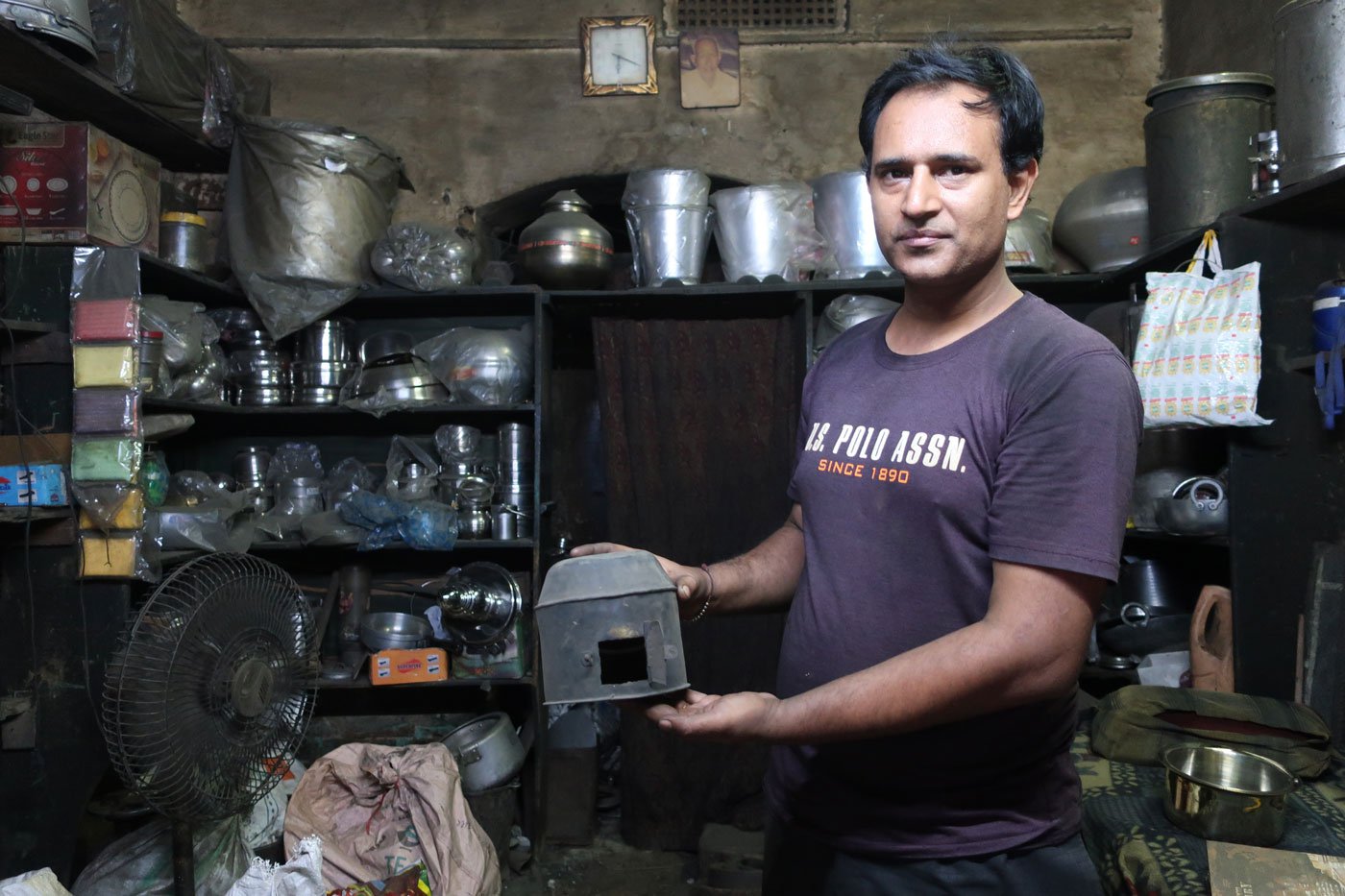
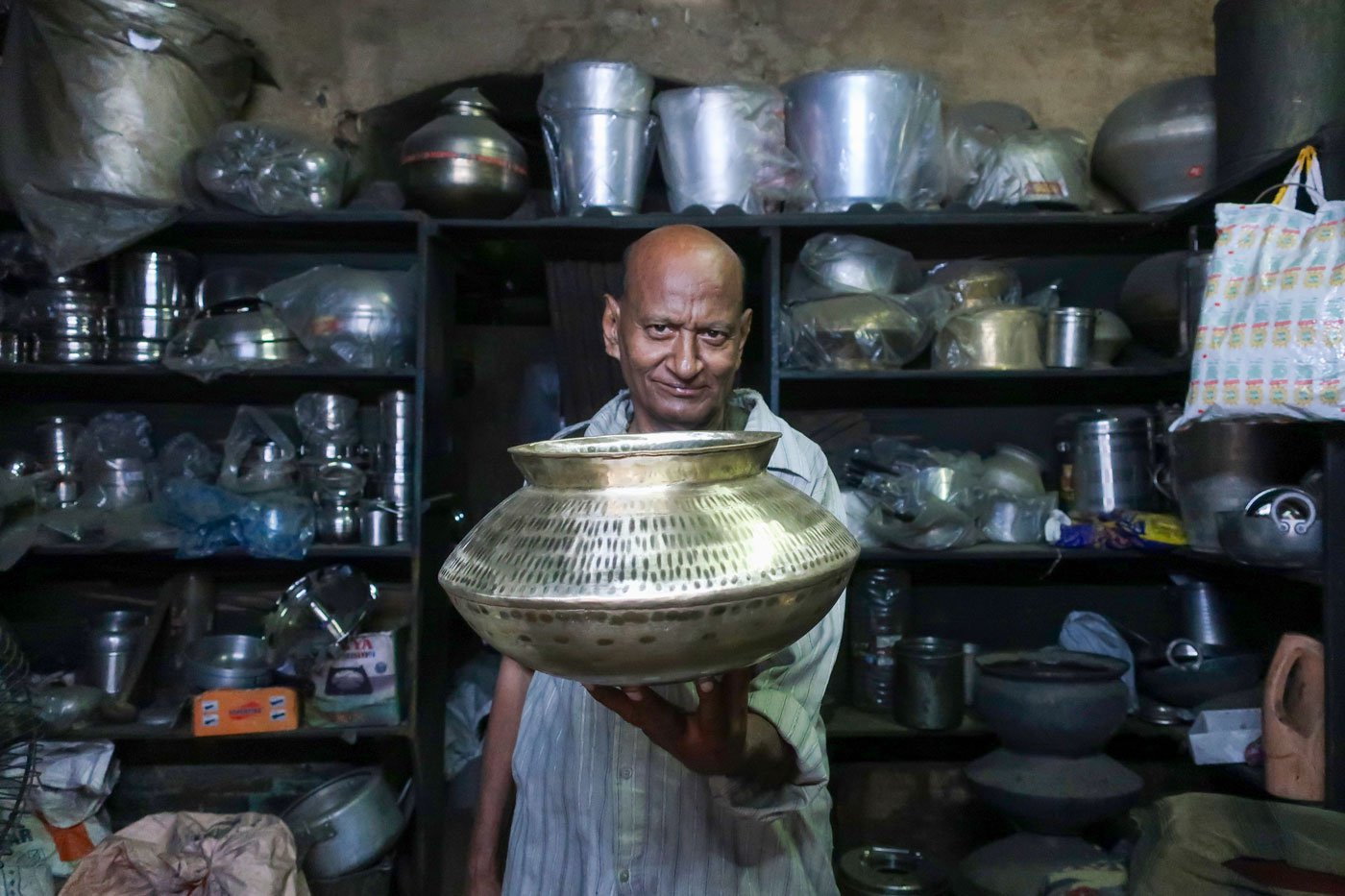
Sunil Kumar (left) shows an old brass item that he made and his father, Kewal Krishan (right) shows a brand new brass patila
In Lehragaga town of Punjab’s Sangrur district where Sunil and his family have been practising the craft for generations, there were two other families of thatheras about 40 years ago. “There was another who had his shop near the temple but he won a lottery of three lakh rupees and then left this profession and closed his shop,” says Sunil, citing the lack of money as the reason to quit.
To keep going, thatheras like Sunil Kumar have started working with steel – both repairing and crafting.
Sunil’s shop is the only one in Lehragaga where one can get their brass utensils cleaned, repaired, and polished. Customers travel from distant villages and cities for this purpose. Though the shop has no name or signboard, people recognise it as the thatheras ’ workstation.
“We have brass utensils at home but they are kept because of their value – both sentimental and monetary value, not for everyday use,” says a customer who has travelled from Dirba village located about 25 km away, to get four baatis (bowls) cleaned at Sunil’s shop. “Steel utensils lose their value after continuous use. They earn you nothing on resale. Brass ones, however, remain valuable,” she says.
Bringing brass items back to life is a popular request that thatheras like Sunil get. When we meet him in September, he is working on utensils that are being passed on by a mother to her daughter on the occasion of the latter’s wedding. The items haven’t been used but the colour has changed over the years and now, Sunil is trying to make them new again.
The cleaning process for brass utensils begins with first checking for green stains caused by oxidation. The utensil is then heated on a small furnace to remove those stains and as the heat turns it black it must be cleaned with diluted acid; afterwards a tamarind paste is rubbed all over and inside to restore the sheen. This changes the colour from brown to reddish-gold.
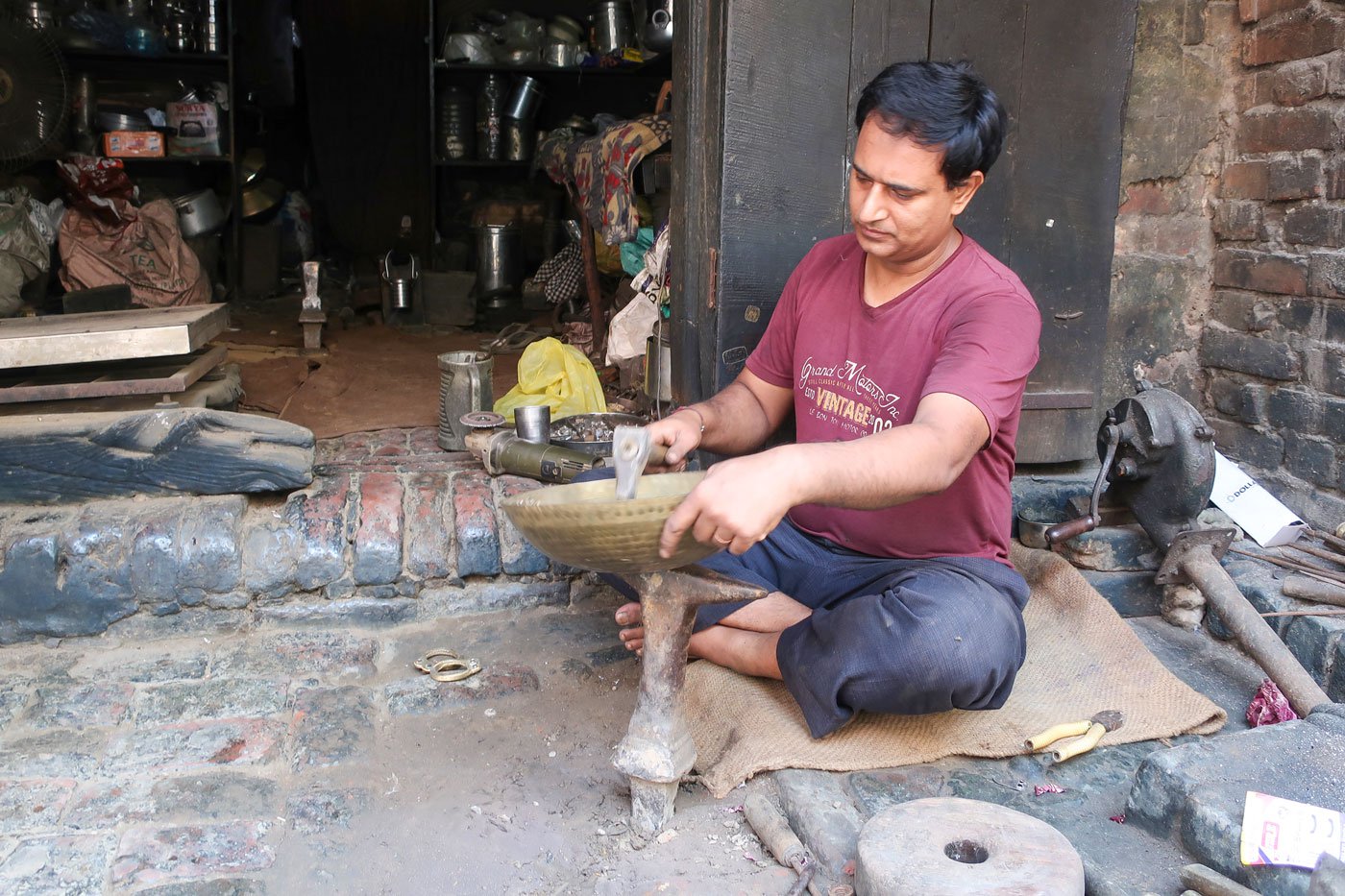
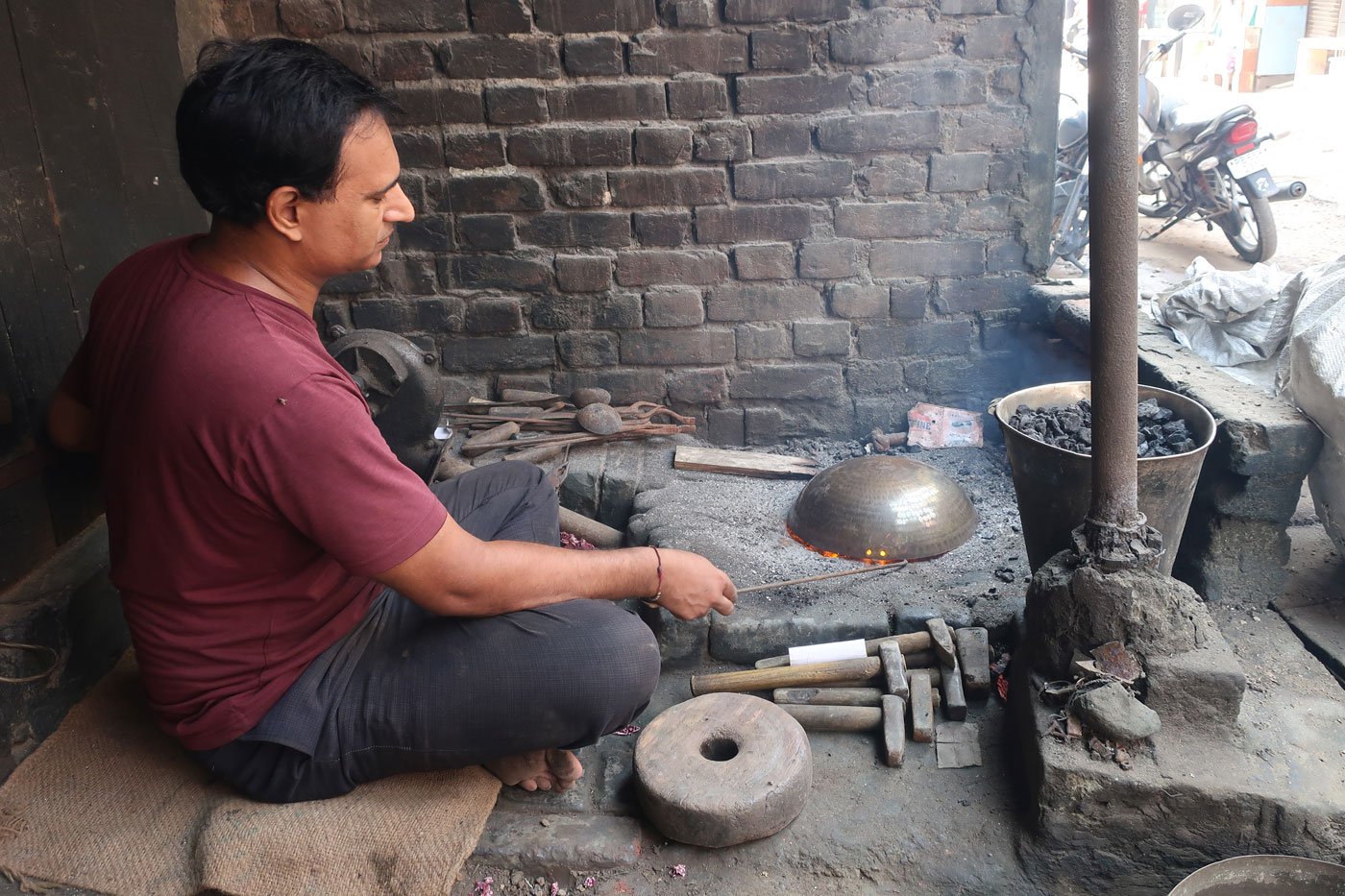
Sunil Kumar removes the handles of a kadhai before cleaning it (left). The utensil is going to be passed on from a mother to her daughter at her wedding. He heats the inside of the kadhai to remove the green stains caused by oxidation
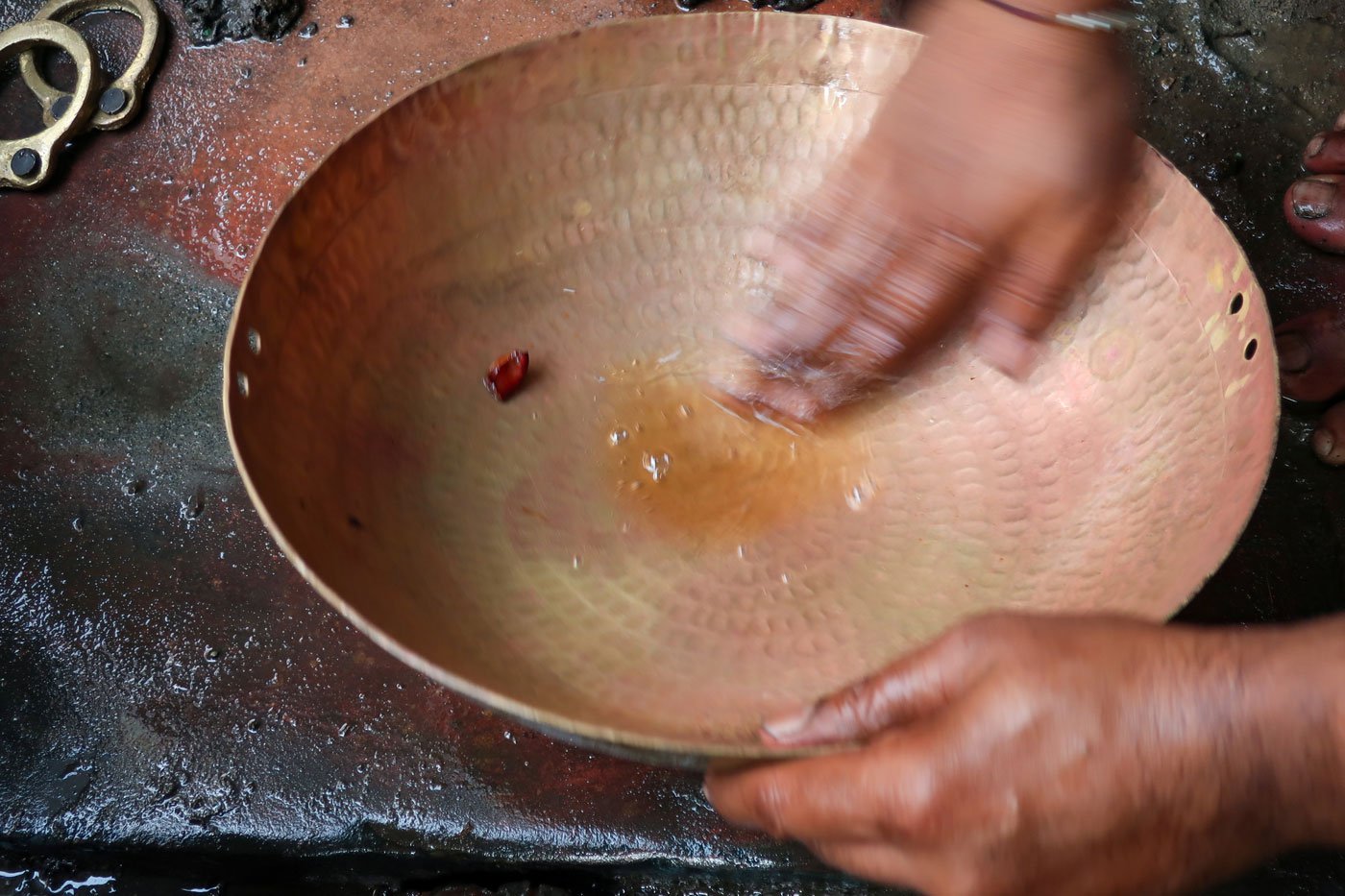
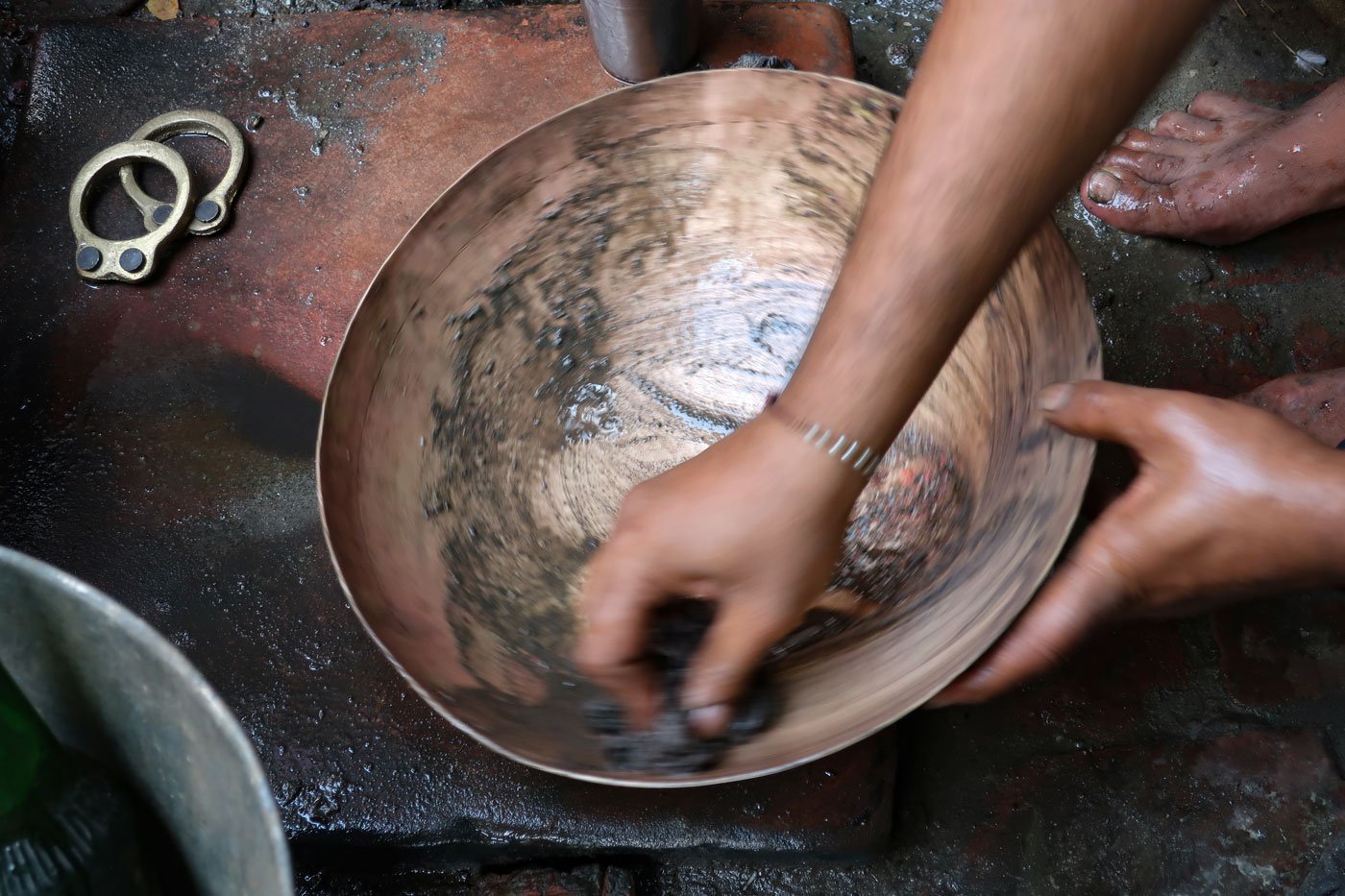
Sunil rubs tamarind (left) on the kadhai to bring out the golden shine. He follows it up after rubbing diluted acid
After cleaning, Sunil uses a grinding machine to turn them golden. “When we didn’t have the grinder, we used regmar [sand paper] to do the same,” he says.
The next step is tikka – dotting the surface of the utensil in a popular design but some customers request a simple polish or a specific design.
Before dotting the kadhai (a large utensil) that he is working on, Sunil polishes the mallets and hammers to get clean, shiny dots on the utensils. The polished instruments gleam like mirrors. He then places the kadhai on a mallet and starts hammering it in a circular motion, bringing out a dotted, glossy golden surface.
Brass utensils which are not used properly or
used for a few years at a stretch, need cleaning and polishing for a golden
shine.
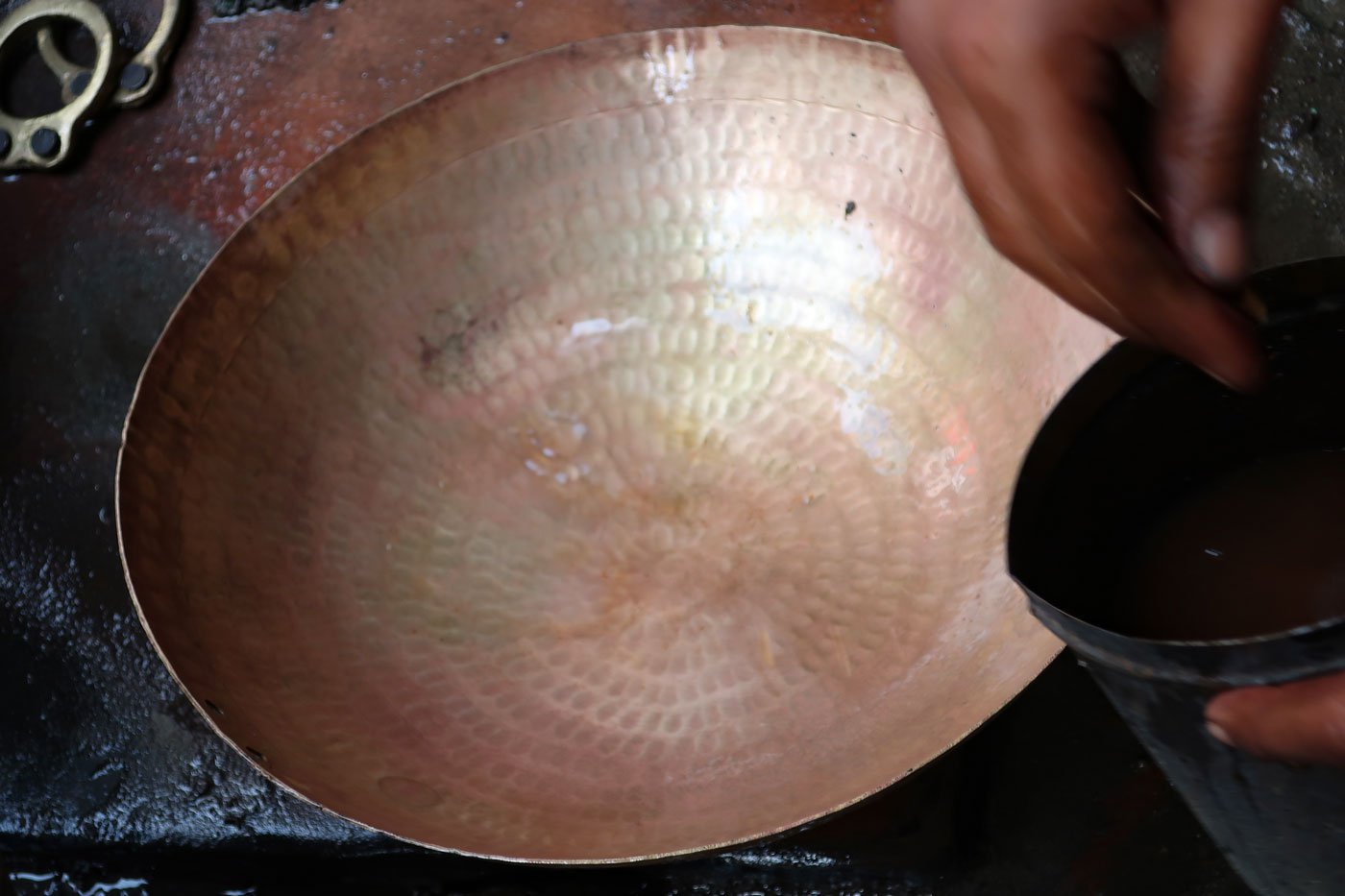
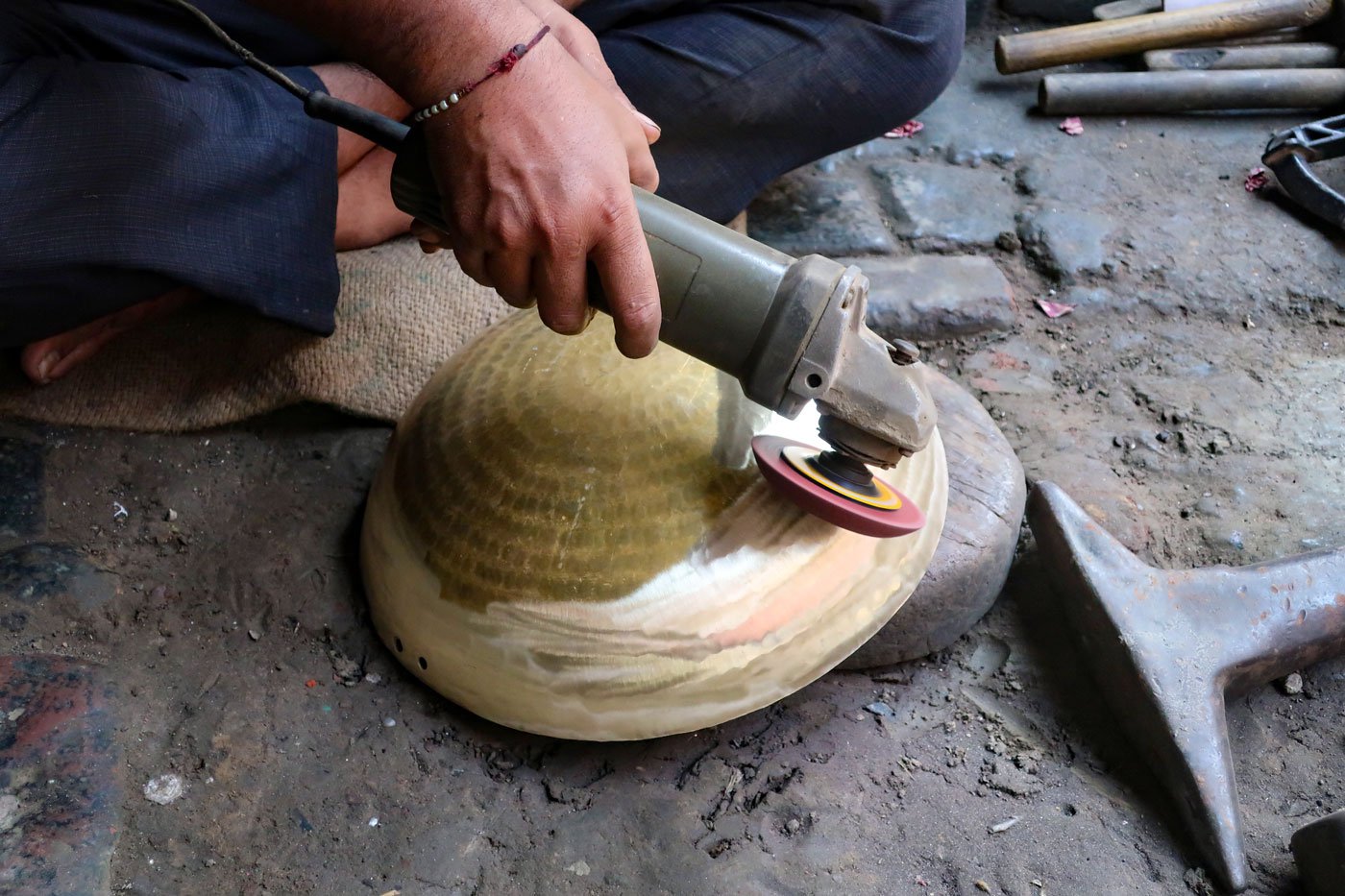
The kadhai shines after being rubbed with diluted acid and the green stains are gone . Sunil Kumar then uses the grinder to give a golden hue
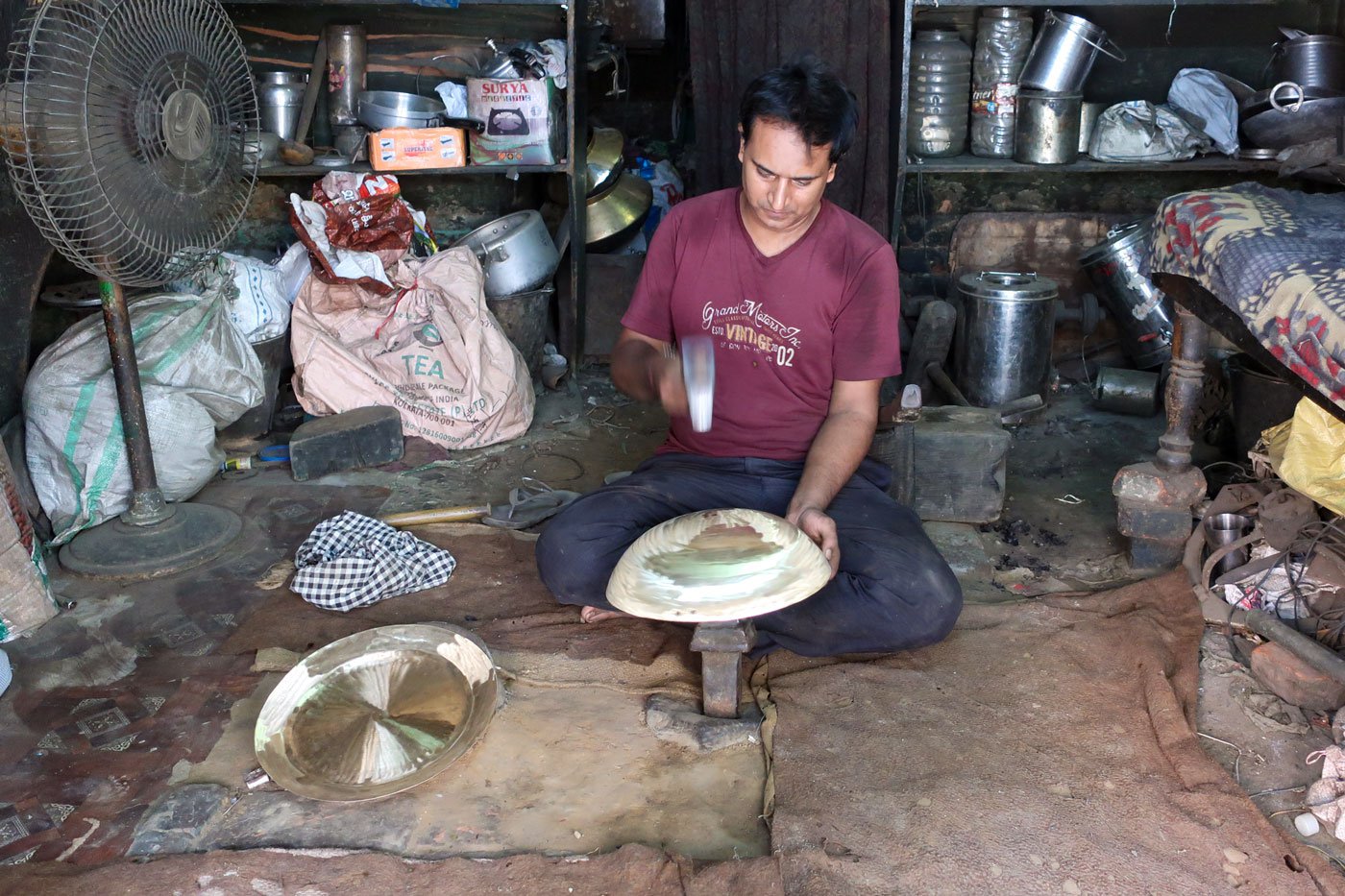
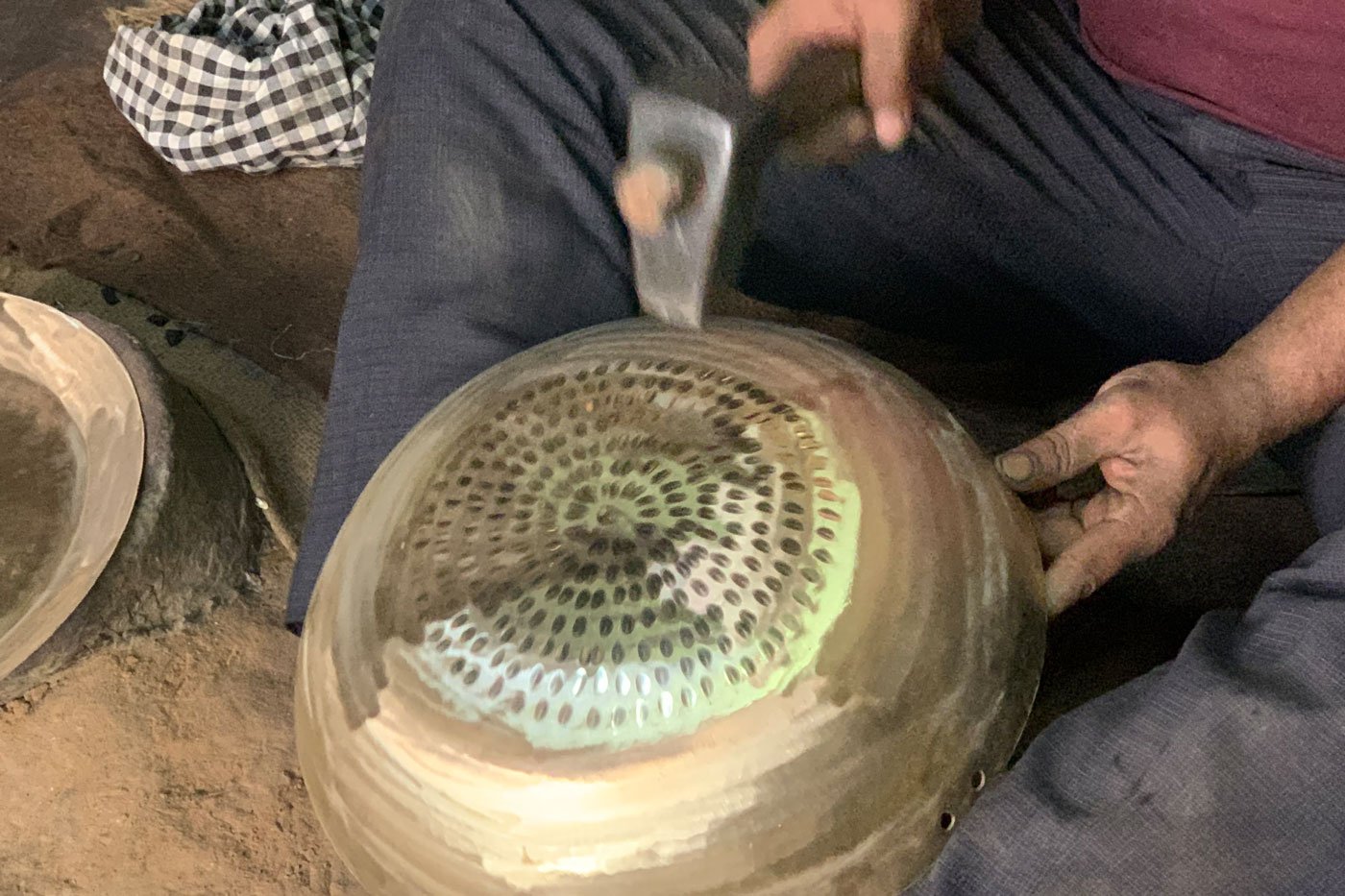
Sunil Kumar dotting a kadhai with a polished hammer
If used for cooking, the brass utensil needs to be coated with tin – a process called kalai , coating of the inner surfaces of brass and other non-ferrous utensils with a layer of tin to prevent chemical reactions with food cooked or stored in them.
‘Bhaande kalai kara lo! ’ Just a few years ago, this was how street vendors would draw in prospective customers wishing to get their brass utensils coated in tin. Sunil says that if one uses the utensils properly, they might go without kalai for five years. Some people, however, get it done after about a year of usage.
During kalai , the brass utensil is cleaned with diluted acid and tamarind paste and heated on a flame till it turns hot pink. A tin coil is rubbed on its inner surface with a sprinkling of what is popularly called nausadar , a powdered mix of caustic soda, ammonium chloride mixed in water. Constant rubbing with a cotton swab produces a white smoke and then magically, in a matter of minutes, the inner surface of the utensil turns silver and the piece is then dipped in cold water.
In recent decades, steel utensils have gained
popularity over brass ones as the former are easy to wash, and there is no fear
of chemical reactions with food. While brass utensils are durable, even
considered valuable, they need specific care. Sunil advises his customers to
clean them immediately after use.
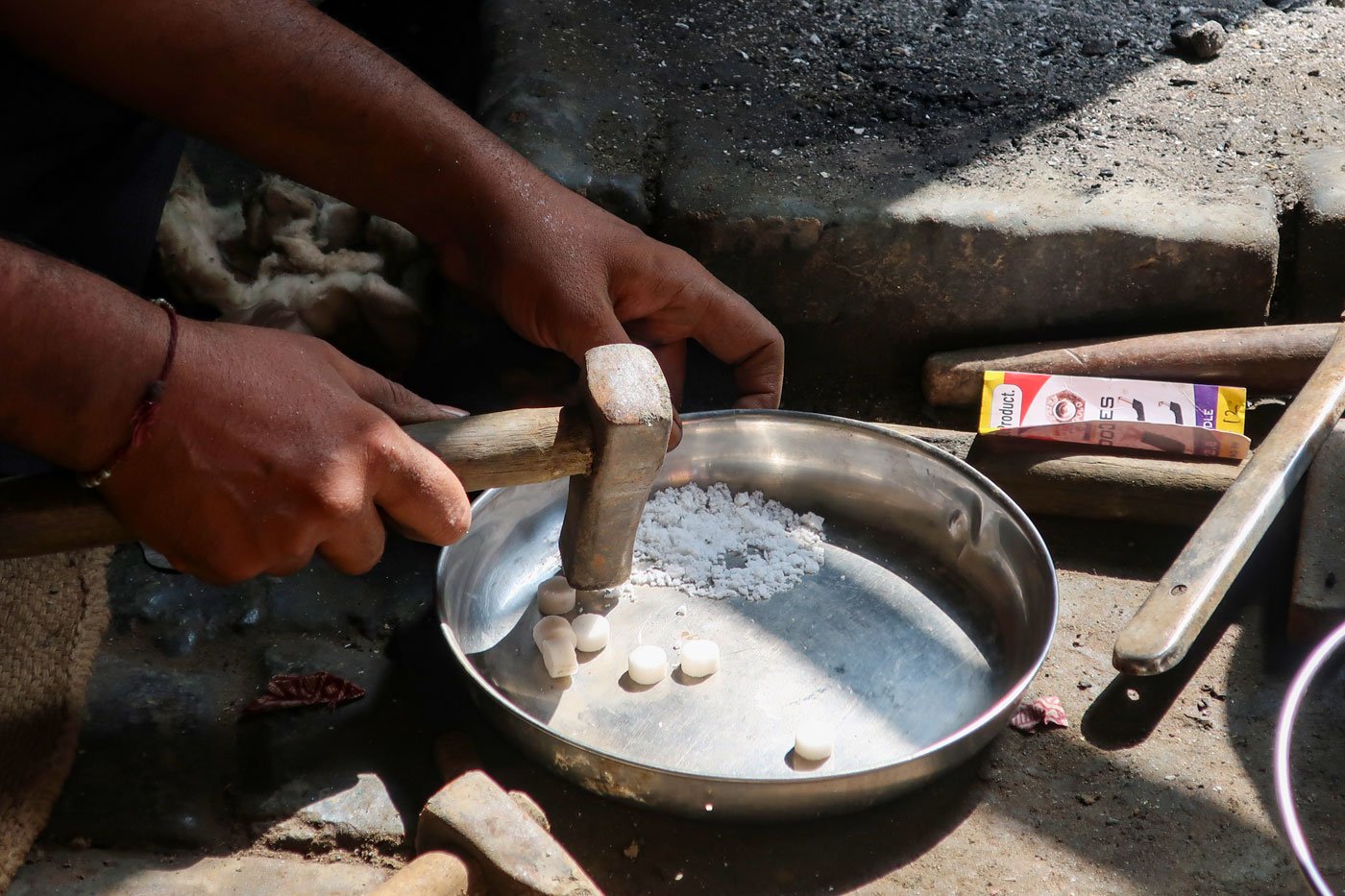
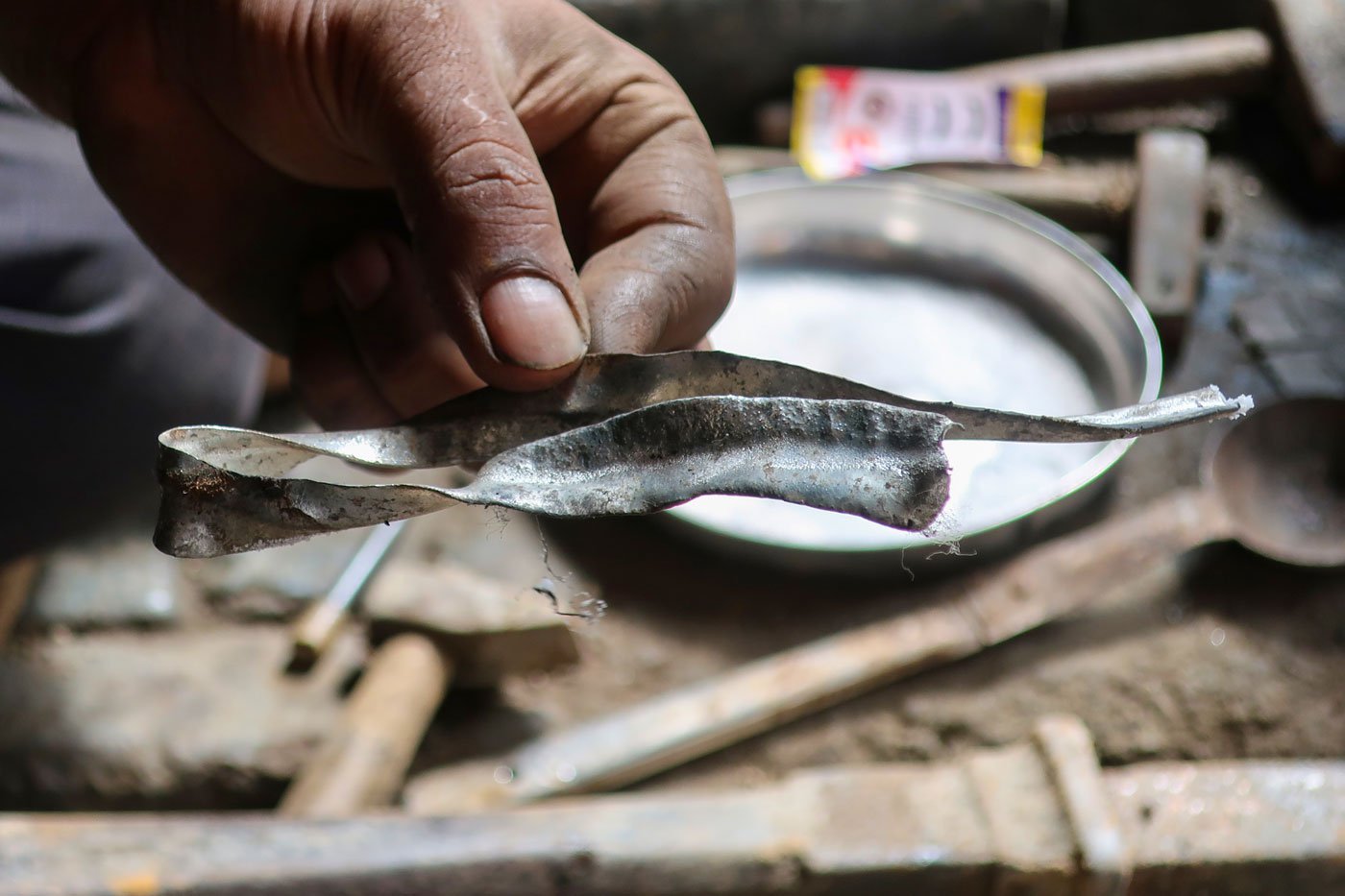
Left: Nausadar is a powdered mix of caustic soda and ammonium chloride mixed in water and is used in the process of kalai . Right: Tin is rubbed on the inside of it
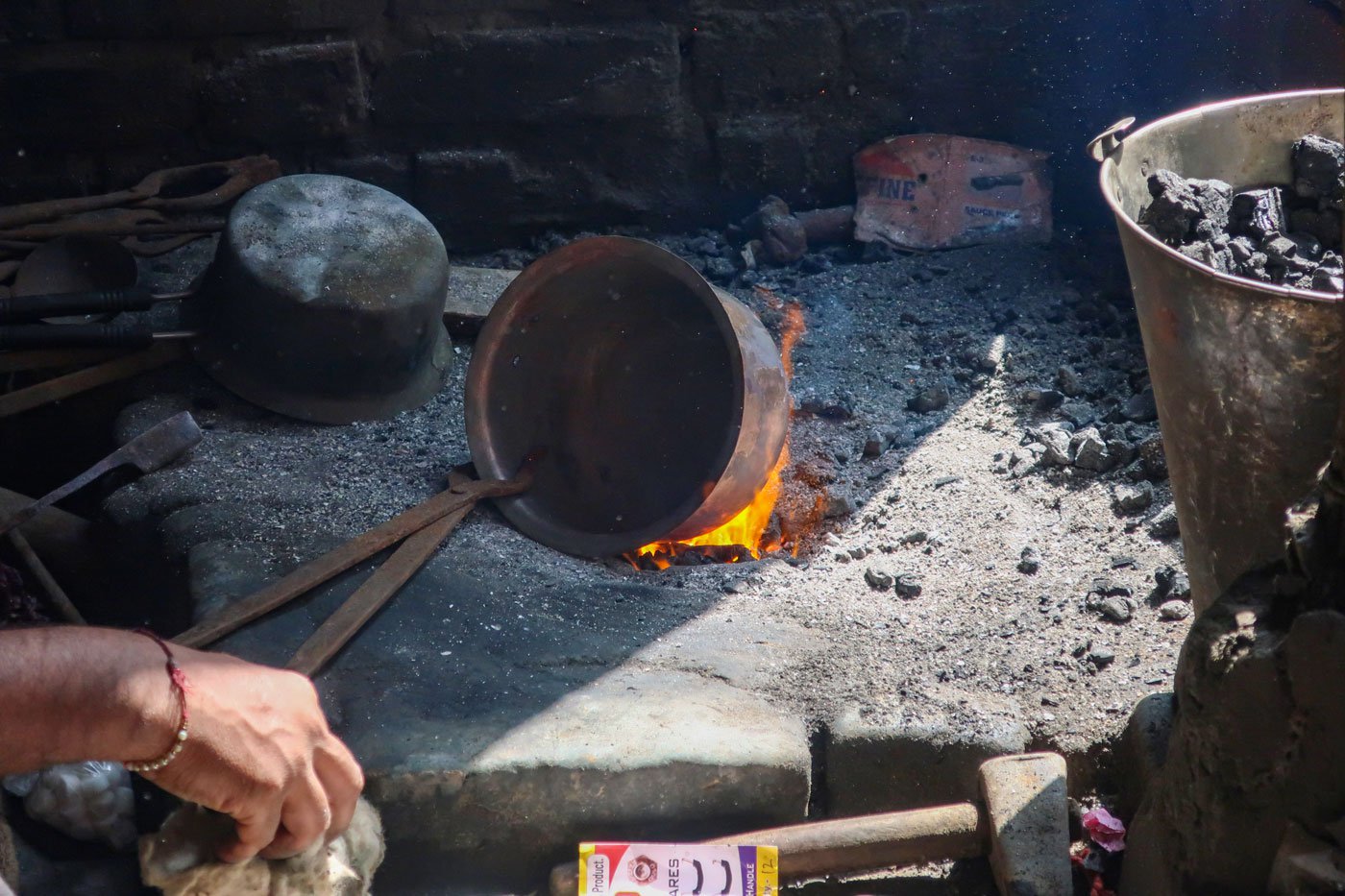
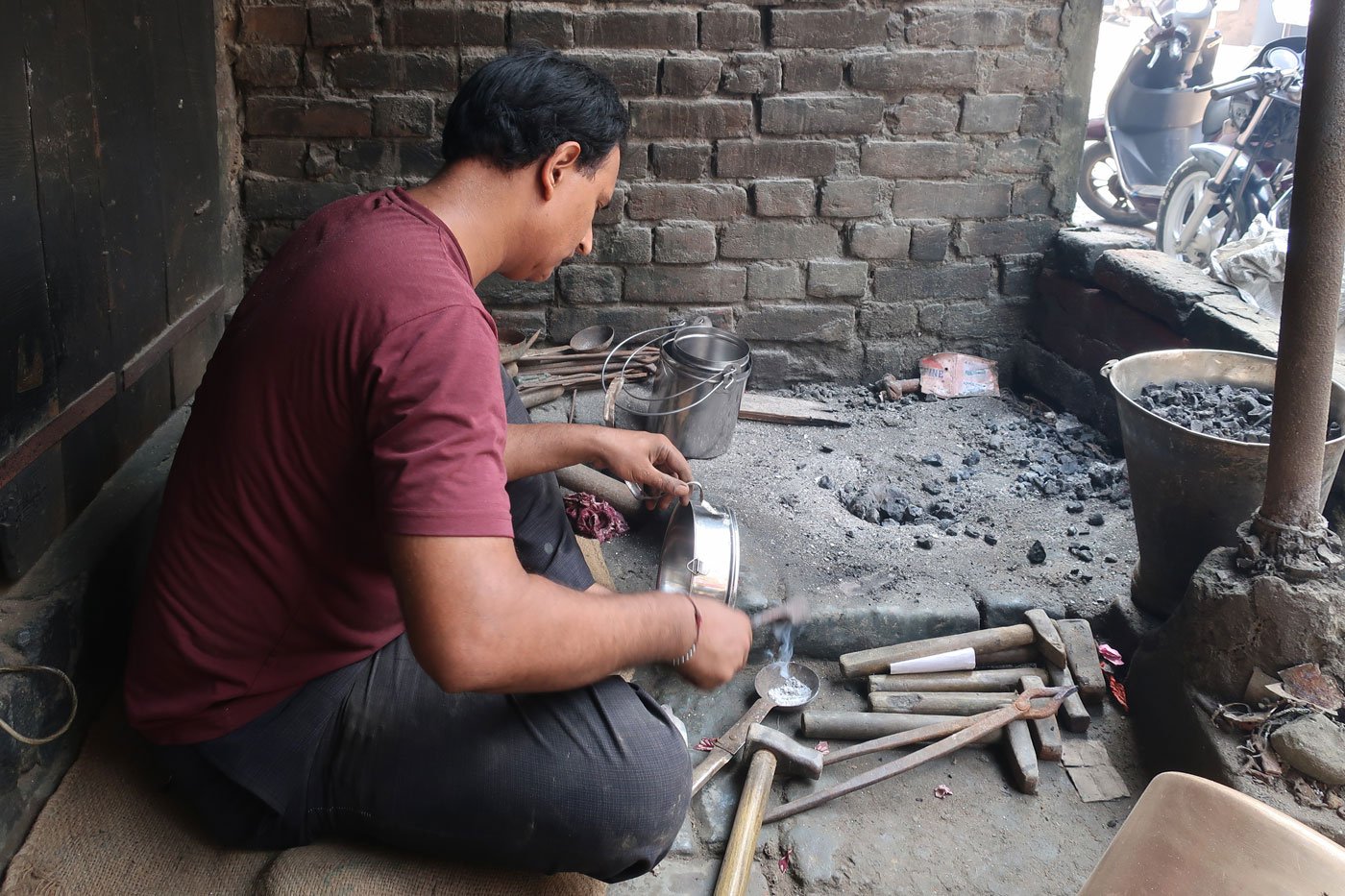
Left: The thathera heats the utensil over the flame, ready to coat the surface . Right: S unil Kumar is repairing a steel chhanni (used to separate flour and bran) with kalai
*****
Sunil’s father, Kewal Krishan had moved to Lehragaga from Malerkotla some 50 years ago when he was a young boy of 12. “Initially I had come for a few days, but then I stayed on,” he says. Generations of the family have been involved in utensil-making – Kewal’s father Kedar Nath and grandfather Jyoti Ram were skilled artisans. But Sunil is unsure if his son will follow him: “My son will follow if he enjoys it.”
Already, Sunil’s brother has moved away from the family occupation and now works at a private telecom company. Other relatives have also moved into other shopkeeping businesses.
Sunil inherited the craft from Kewal Krishan. “My father was injured when I was in Class 10. I had to stop my education and take up the business to earn our livelihood,” he says as he hammers away at his utensils. “As a schoolboy I used to come to the shop in my free time and experiment with creating something or the other. Once I made a replica of an air cooler in brass,” he shares proudly.
The first piece he ever crafted was a small patila which he sold. Since then he says he tries to build something new whenever he has time away from work. “I made a money box for my sister, with a face designed on it,” he recounts. For his home, he has also made one or two brass utensils which are placed inside water containers for the benefits of the metal.
In recent decades, steel utensils have gained popularity over brass ones as the former are easy to wash, and there is no fear of chemical reactions with food
The thathera community in Punjab’s Jandiala Guru was recognised by UNESCO under the category of Intangible Cultural Heritage in 2014. It is one of the few places where the community and business of thatheras is still surviving, owing to the recognition from UNESCO and the continued usage of brass utensils in gurdwaras across Amritsar.
Large deghs (utensil in which food is cooked) and baltis (buckets) are still used in gurdwaras to cook and serve meals. However, some gurdwaras have transitioned away from using brass utensils because of the challenges in maintenance.
“We now primarily engage in repair work. We do not have time to make new utensils,” points out Sunil, a serious shift from the time when they made brass and bronze utensils from scratch. One artisan could make 10-12 patilas (food storage pots) a day. However, changing demand, cost, and time constraints have shifted utensil-makers’ focus away from production.
“We do it on order, but we do not make and store them,” he says and adds that big companies buy utensils and other products from thatheras and sell them at four times the price.
Thatheras
set the price of brass utensils according to the
weight and quality of metal used, as well as the piece. For example, a
kadhai
may sell at Rs. 800 per kilogram.
Since brass utensils are sold at rates as per their weight, they fetch higher
prices than steel utensils.
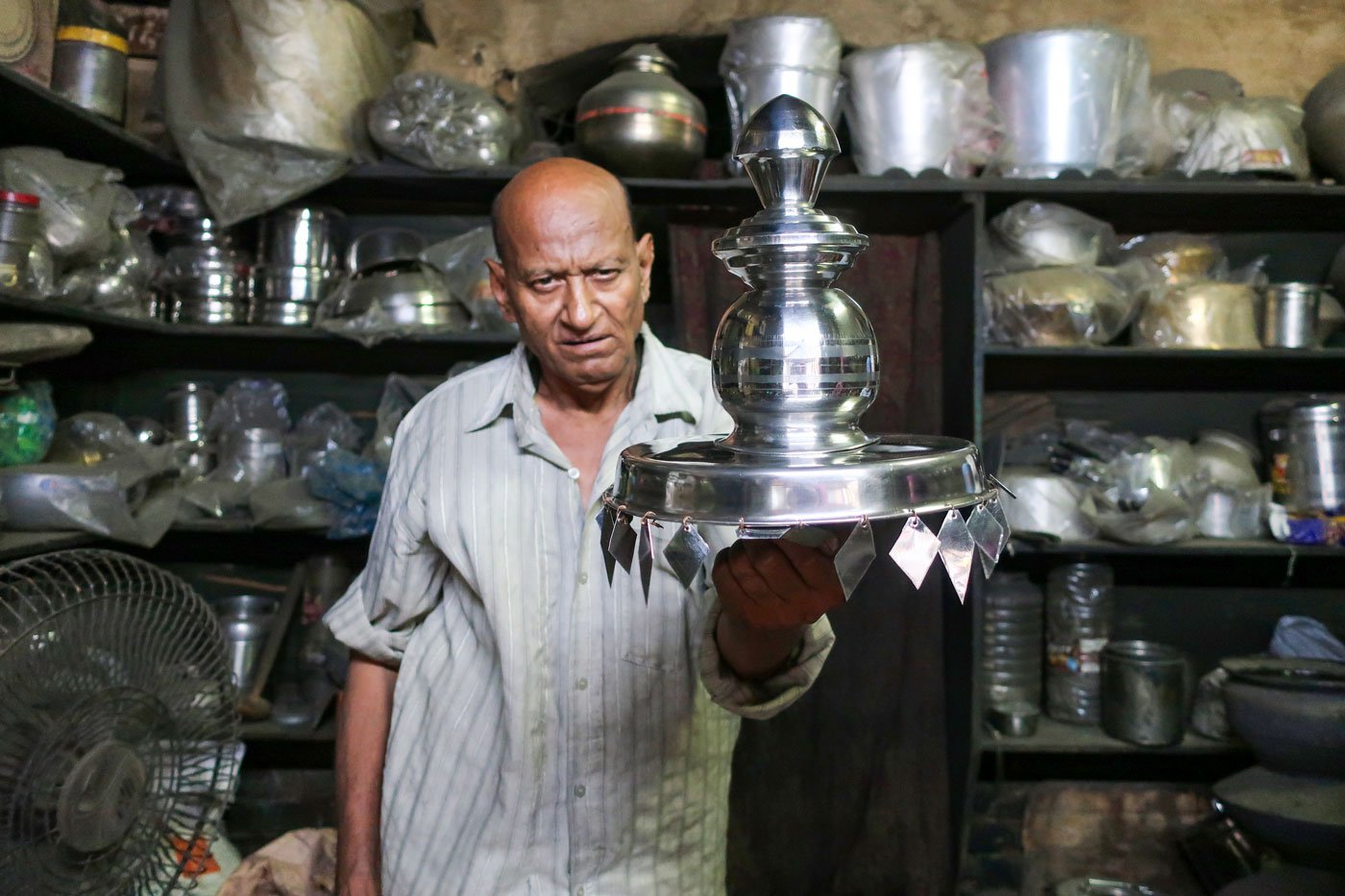
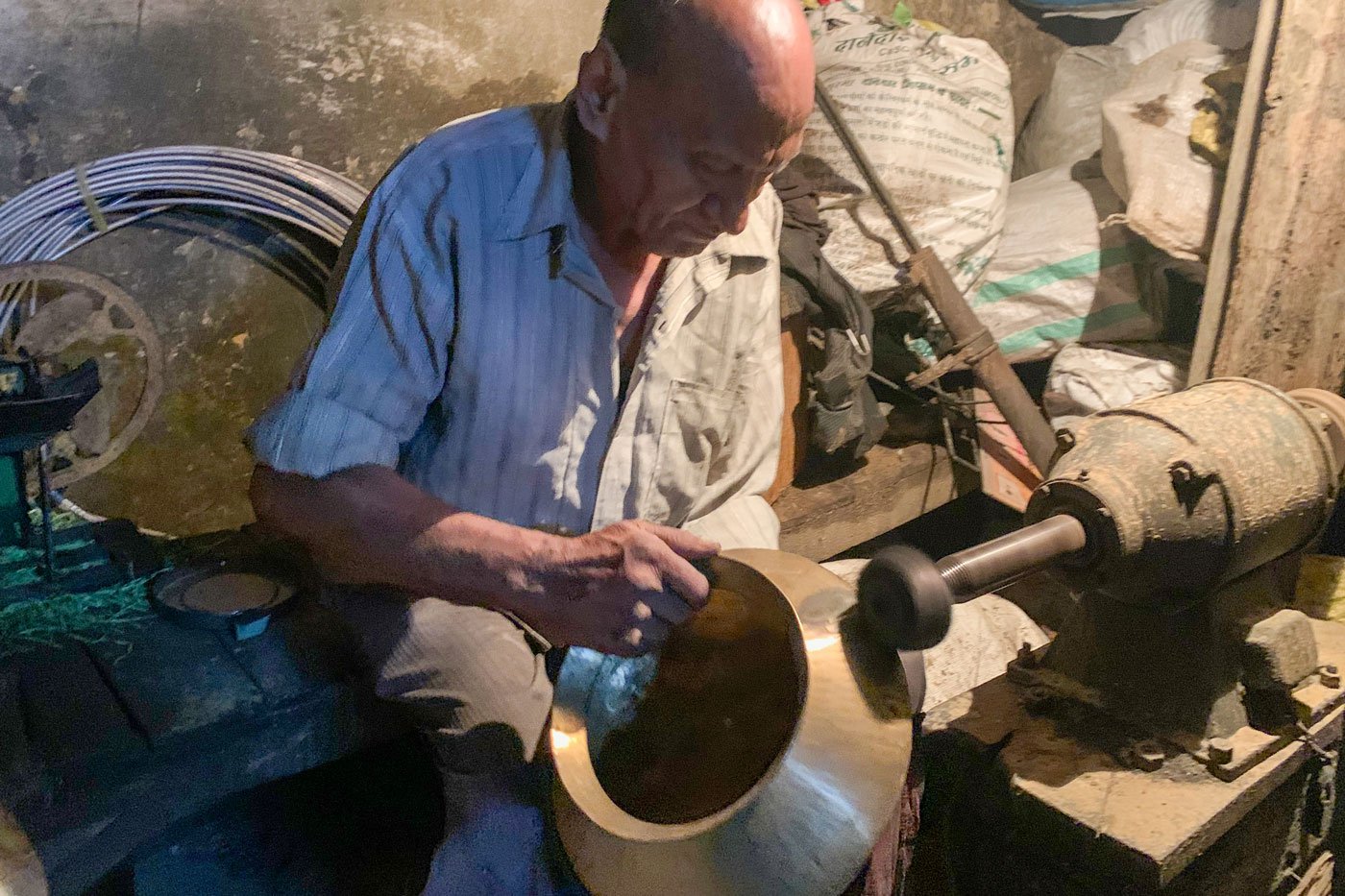
Left: As people now prefer materials like steel, thatheras have also shifted from brass to steel. Kewal Krishan shows a steel product made by his son Sunil. Right: Kewal dotting a brass kadhai which is to pass from a mother to a daughter
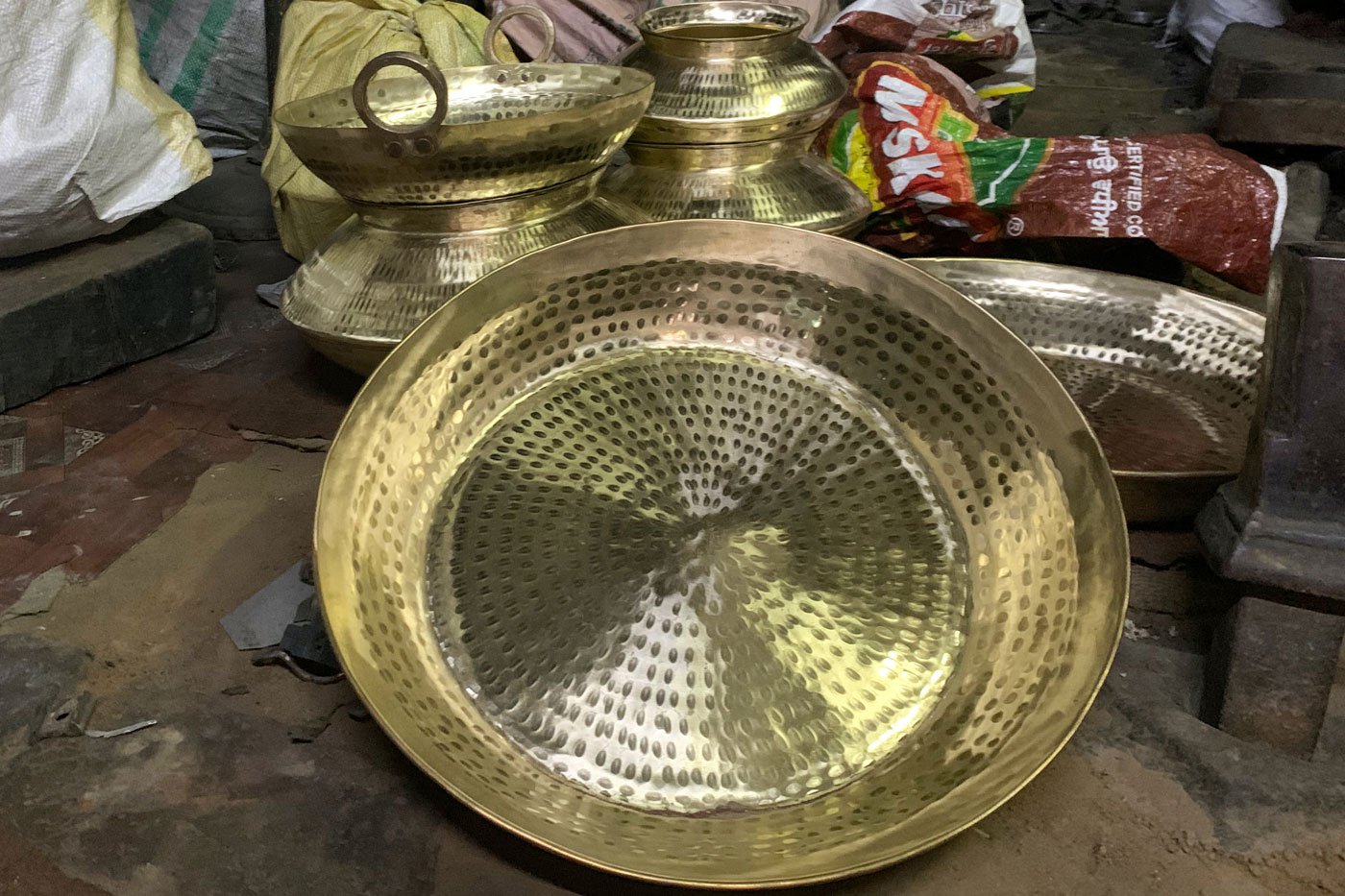
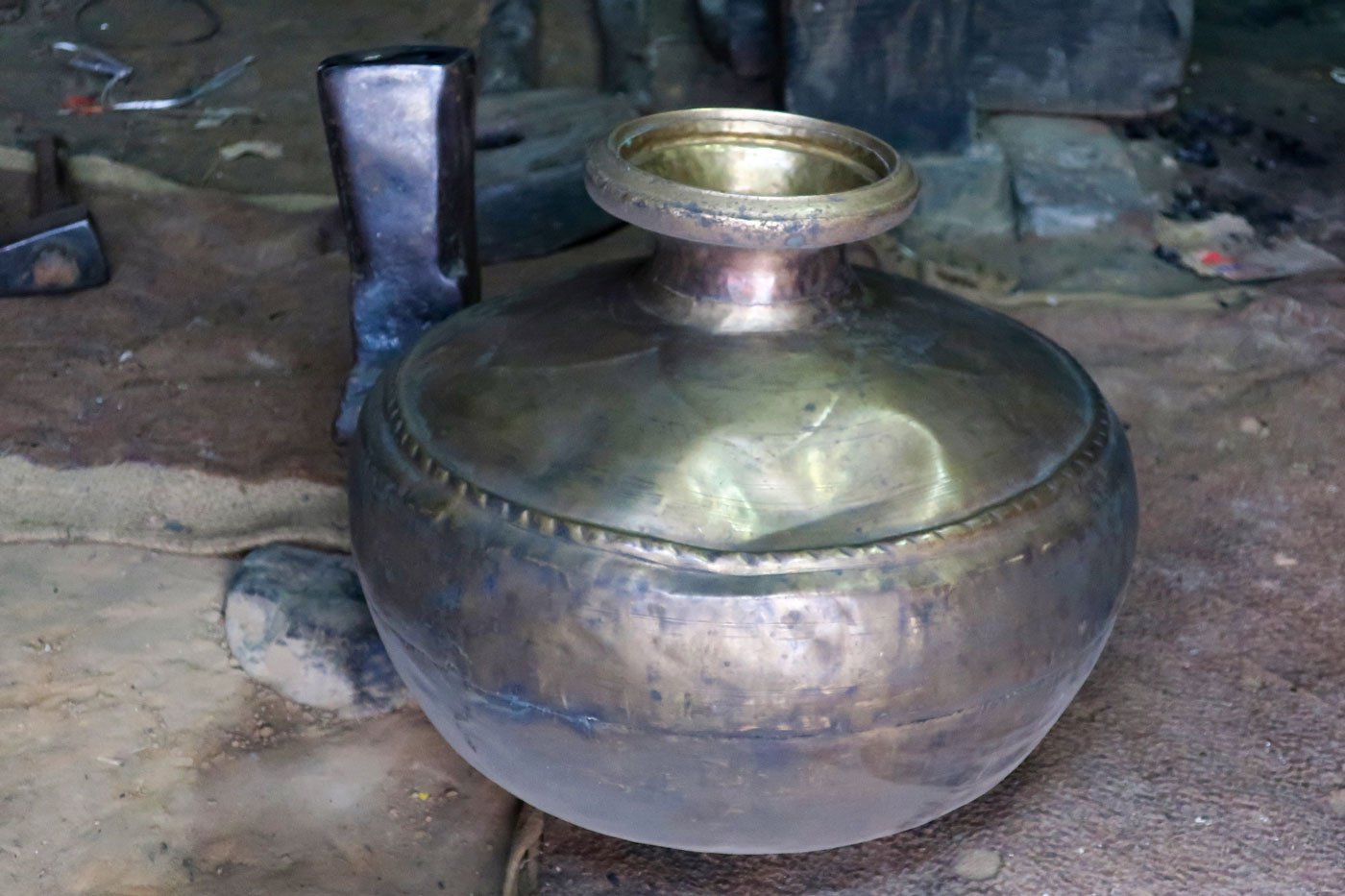
Left:
Brass utensils at Sunil shop. Right: An old brass
gaagar
(metal pitcher) at the shop. The
gaagar
was used to store
water, milk and was also used to create music at one time
“We used to make new utensils here. About 50 years ago, the government gave us quotas to get zinc and copper at subsidised prices. But now the government gives the quota to factories, not to small businessmen like us,” rues Kewal Krishan. In his sixties, he spends his time supervising work at the shop while also hoping the government will revive the subsidy.
Kewal explains how they traditionally made brass by mixing together 26 kilos of zinc and 14 kilos of copper. “The metals would be heated and mixed together, and put in small bowls to dry. Then the bowl-shaped metal pieces were rolled into a sheet which was moulded into different shapes for different utensils or craft pieces,” he says.
In this region, there are only a few rolling mills left where thatheras can get metal sheets to mould for artwork or utensils. “Either we obtain it from Jandiala Guru in Amritsar (234 km from Lehragaga) or from Jagadhari in Haryana (203 km away). We get metal sheets which we then mould into utensils as per the customer’s wishes,” Sunil explains.
Kewal brings up the Pradhan Mantri Vishwakarma scheme (announced in September) under which the government will provide up to Rs. 3 lakh collateral-free loan to artisans and craftspeople like blacksmiths, locksmiths, toy makers and 15 others, but not thatheras.
Income is uncertain in repair work- somewhere around Rs. 1,000 depending on the day and Sunil thinks producing new utensils could help their business. Of late, he has sensed some revival of interest in brass utensils and is hopeful that the tradition will survive.
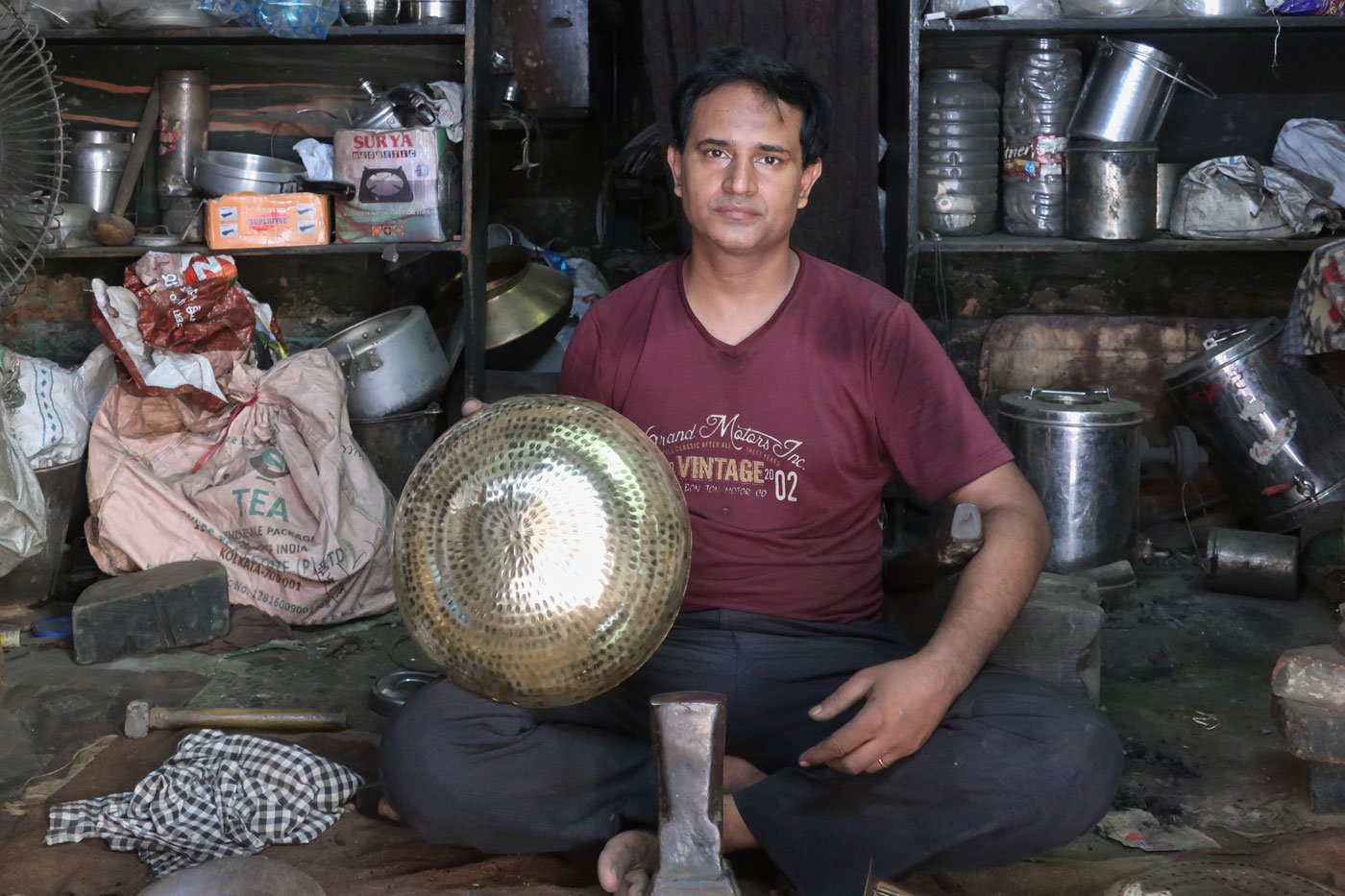
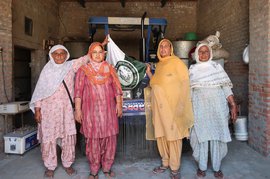

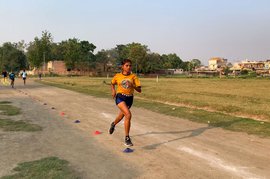
![‘They [BJP] do not have the right…’](/media/images/01-IMG_2898-AA-They_BJP_do_not_have_the_right.width-270.jpg)